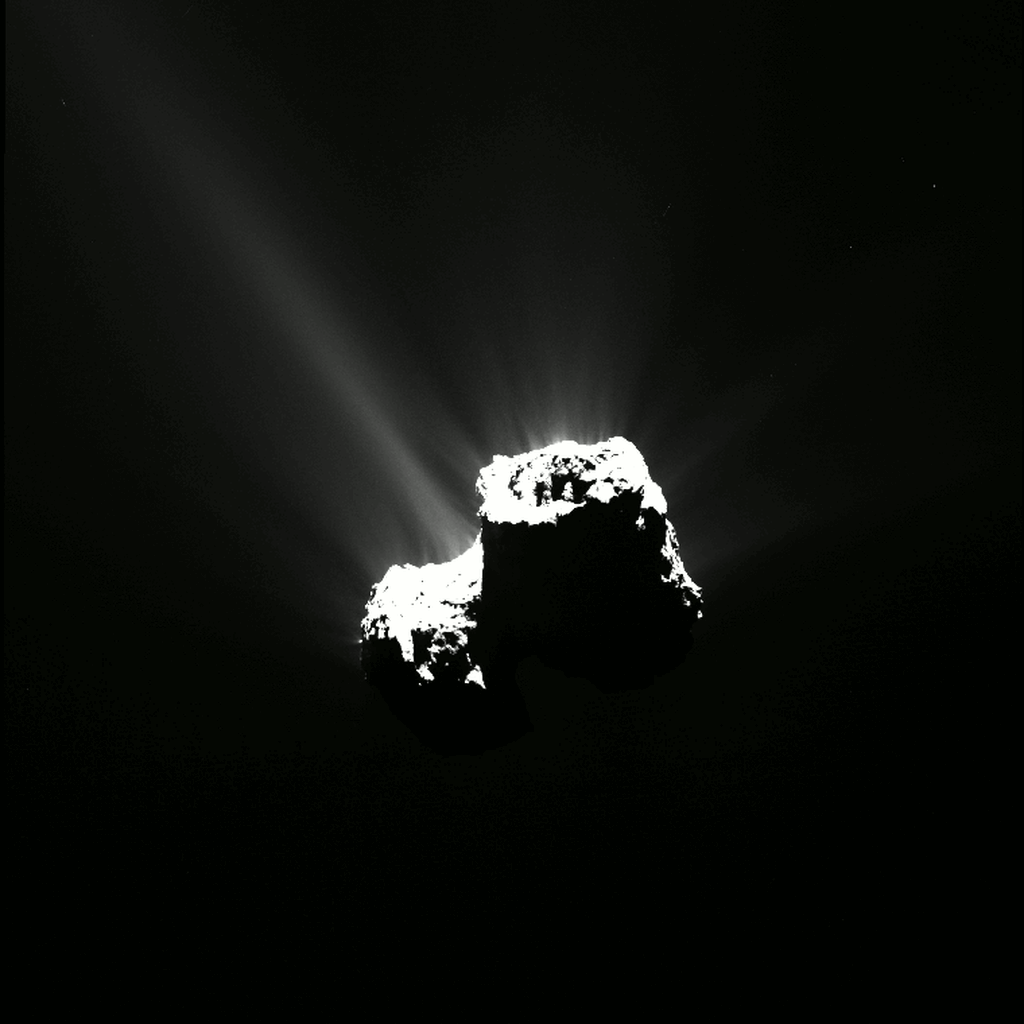Rosetta’s comet reaches perihelion
Comet 67P/Churyumov-Gerasimenko is now travelling away from the Sun. Cometary activity will, however, increase in the next weeks.
Turning point in the Rosetta mission: Tonight at 4.03 am (CEST) 67P/Churyumov-Gerasimenko reached the point in its orbit closest to the Sun. Since the solar heat only gradually penetrates into the comet’s deeper, ice-bearing layers, it is expected to reach its peak of activity only in the coming weeks. Nevertheless, shots taken by OSIRIS, the scientific imaging system onboard Rosetta, on 12 and 13 August (CEST) already show a firework of dust jets emitted from the comet – and a spectacular outburst.
Last night, only 186 million kilometers separated Rosetta’s comet from the Sun. However, the comet’s strongly elliptical orbit did not bring it truly close to our star: 67P remained well outside the Earth’s orbit. The comet is currently experiencing the strongest solar illumination on its journey through the Solar System. Under the influence of the radiation, sub-surface layers are heated up, gases evaporate and carry jets of dust with them into space.
The myriads of dust particles surrounding the comet by now are making it difficult to navigate Rosetta close to the comet. For weeks now, the space probe has therefore kept a safe, rather large distance from the nucleus. The new OSIRIS images taken on 12 and 13 August (CEST) were taken from a distance of approximately 300 kilometers. A dazzling display of dust jets surrounds the body like a halo. One of the shots in this sequence also reveals a particularly violent outburst. Rosetta observed a similar event already on 29 July.

First signs of gas and dust activity could already be found in May last year, when the comet was still more than 600 million kilometers from the Sun. Since then, activity has increased steadily. "But in recent weeks, the 67P’s behavior has also changed qualitatively," says OSIRIS Principal Investigator Holger Sierks from the Max Planck Institute for Solar System Research (MPS).
"The dust jets have become very stable," OSIRIS-scientist Jean-Baptiste Vincent from the MPS describes. "They usually continue for several weeks only breaking-off briefly when the particular side of the comet turns away from the Sun.” The starting points of the jets on the comet’s surface can be mapped in a two-dimensional representation. They are all located in the vicinity of the subsolar line, the latitude over which the Sun is currently at its zenith.

Unlike at the beginning of the mission, the dust jets are also no longer emitted primarily from the comet’s neck. Instead, now the Imhotep region on the comet’s underside harbors the starting points of the strongest activity. The reason for this shift can mainly be found in the comet’s gradual change in orientation during its orbit around the Sun: more and more regions on the southern hemisphere are being illuminated; the neck receives only very little sunlight.
Areas on the underside of the comet, which at the beginning of the mission experienced a polar night, a period of permanent darkness, are therefore now becoming visible. Scientists from the OSIRIS team have classified this “uncharted territory” into four distinct regions, which differ in their surface properties. As the 19 previously known regions, they are were assigned the names of Egyptian deities: Anhur, Wosret, Sobek, and Khonsu. While some appear very rugged, others have a much smoother terrain.

Apart from small dust grains, the comet is now also hurling significantly larger chunks into space. In three shots from 30 July, a boulder can be seen leaving the comet. Its exact size can, however, not be determined. For this, its distance from Rosetta and thus its trajectory would have to be known. Both cannot be reconstructed from only three shots. "If the object has the same distance from the spacecraft as did the comet itself at this time, about 185 kilometres, it measures about 50 meters in diameter”, says OSIRIS scientist Sonia Fornasier from the Paris Observatory, who discovered the boulder in the images. But even if it were much closer to the probe, it would at least be about one meter in size. "This is the first boulder, which covers more than one pixel in our images. We can therefore now distinguish a shape and structure," says OSIRIS project manager Carsten Güttler from the MPS.

For the next few weeks, the researchers expect the fireworks of gas, dust, and boulders to increase still. Although already last night 67P experienced the strongest illumination during its six and a half-year journey around the Sun, comets usually react to this barrage of heat with a few weeks’ delay. "The comet stores the heat and it takes a while until it penetrates into deeper, ice-bearing layers," says Güttler.
"We are excited about what Rosetta’s comet will have to offer in the coming weeks," says Sierks. "We expect this to be just the beginning of the fireworks.”
Rosetta is an ESA mission with contributions from its member states and NASA. Rosetta's Philae lander is provided by a consortium led by DLR, MPS, CNES and ASI. Rosetta is the first mission in history to rendezvous with a comet, escort it as it orbits the Sun, and deploy a lander to its surface.
The scientific imaging system OSIRIS was built by a consortium led by the Max Planck Institute for Solar System Research (Germany) in collaboration with CISAS, University of Padova (Italy), the Laboratoire d'Astrophysique de Marseille (France), the Instituto de Astrofísica de Andalucia, CSIC (Spain), the Scientific Support Office of the European Space Agency (The Netherlands), the Instituto Nacional de Técnica Aeroespacial (Spain), the Universidad Politéchnica de Madrid (Spain), the Department of Physics and Astronomy of Uppsala University (Sweden), and the Institute of Computer and Network Engineering of the TU Braunschweig (Germany). OSIRIS was financially supported by the national funding agencies of Germany (DLR), France (CNES), Italy (ASI), Spain (MEC), and Sweden (SNSB) and the ESA Technical Directorate.



